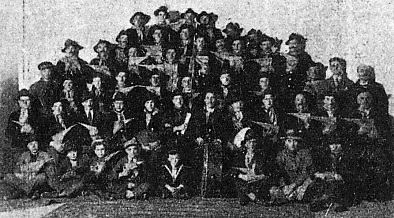 ITALIAN
PANFLUTES
ITALIAN
PANFLUTES
PANFLUTES
AND BAMBOO
article published
in the
American Bamboo Society Magazine,
dec. 2000
Introduction:
Several authors consider the pan flute
to be the first musical instrument. Whether this true or not, pan
flutes have undoubtedly maintained their popularity in the past and continue
to do so in many cultures, and there are few people who do not enjoy their
peculiar sound. When these authors try to justify this concept, they
say that ancient men and women were inspired by the wind blowing through
bamboo clumps. Again, whether this true or not, it is undeniable
that there is a strong relationship between pan flutes and bamboo.
Indeed, bamboo is drawn to be a pan flute. It is almost certain that
the first pan flutes were made from bamboo or similar plants with a holed,
tubular structure. Later on, pan flutes were made from different
materials, such as stone or clay, and much later on ceramics and metals
were adopted for pan flute manufacture. Modern pan flutes are also
made in wood or plastic, but none capture the peculiar resonance of those
made in bamboo.
What is a pan flute?
The main difference between a pan flute
and a multi-holed flute, is that with the first one can obtain only one
note per tube, while with the second one can vary the pitch of the instrument
by covering or uncovering holes. Essentially, a tube open at one
end and closed at the other is a pan flute. The longer the tube, the deeper
the sound. A real pan flute is a group of tubes, the collection of
which form an individual flute.
Different characteristics of the tube
shape give different qualities to the sound. Of greater importance
are the ratio between length and internal diameters, the thickness of the
wall of the tube, and the cylindrical versus the tapered internal shape.
A narrow tube produces a sound with a high content of upper harmonics.
Translated into a pan flute, a vibrant, piquant sound is produced.
An extremely narrow tube does not produce the fundamental note; or rather
it does, but mixed with the harmonics. On the other hand, a fat tube
of the same length produces a rounded sound. The first ones can be
roughly compared with consonant letters of "g" or "r", while the second
with the vocals of "u" or "o".
The different types of
pan flutes around the world:
Some of the most famous, are those from
the Andean region, generically called siku or antaras. Large groups
of sikuri (siku players) can be found in Bolivia, Perú and north
of Argentina and Chile. On the other hand, one can mention the European
pan flutes, known as Romanian pan flutes, although it was used widely throughout
Europe. The siku is a pan flute organized in such a way that it needs
two to play the whole scale. The banda de sikuri (a traditional pan
flute orchestra) is composed of twelve siku. Each musician has a
half of the scale alternated with the half of another one, and the melodies
are performed alternatively, creating a stereophonic effect. This
is a true communal action, though an outsider cannot notice this group
action.
Example:
Musician A plays the D, F#, A, C, E, G,
B, and D.
Musician B plays the E, G, B, D, F# ,A,
and C.
Selecting bamboo and the
resulting acoustic consequences:
Each culture made their own unique musical
instruments with the materials that they had at hand. The South American
ones are traditionally made using the bamboo Rhipidocladum harmonicum,
known locally as “Chuki” or “Chussi”. The characteristics, is
the long internodes are markedly cylindrical with very thin walled.
Another species highly favored, is Rhipidocladum neumanii (Sulekic, Rúgolo
and L.G. Clark), which has recently been described in N.W. Argentina and
Bolivia.
The original European pan flutes were
made from Arundo donax, which although being a grass, is not a bamboo.
Arundo donax has shorter internodes than the Rhipidocladum genus.
Although there are countless types of pan flutes in South America, one
can say that they are narrower than the European ones, with the expected
consequences to the sound, as mentioned above.
The long internodes of Rhipidocladum species
allow to the flute maker (known as sikulururi in Los Andes) to easily achieve
bass notes with narrow tubes, where the length-diameter ratio might be
30 or more (that is, the length is 30 times that of the internal diameter).
The thin walled Rhipidocladum reinforces the harmonic characteristics of
the narrow tube. The reason for this, is at the embouchure (mouthpiece)
rather than the resonating qualities of the material. Following the
principals of acoustics, the energy of the resonant air into a tube is
not enough to make the walls resonate. However, at the embouchure,
the sharpness of the edge where the musician blows produces more harmonics
than a rounded one. The thin walls also make the tubes very close
one to another. So, when one blows one note, unavoidably one also
excites the neighboring ones. Due to the organization of each row
of tones described above, the musician excites the neighboring 3rds notes,
and as a result, the natural harmonics of the main note are also played.
Another characteristic of a thin walled pan flute is that is easier to
play, for the simple reason that the lips of the player are nearer to the
air column than blowing a thick walled one.
European pan flutes obtain more individual
notes. The alignment of the tones follows a diatonic scale (the normal
C, D, E, and so on). There are large pan flute orchestras in Europe,
but the way each flute plays is the same as other instruments, where each
musician has its part of the melody.
. ITALIAN
PANFLUTES
ITALIAN
PANFLUTES
The Andean antara is a single row of tubes
equivalent to the European pan flute, but normally adopts the pentatonic
instead of the diatonic scale, the original Inca music scale was composed
of 5 notes.
Pan flutes in South America are also made
from other bamboo, such as Aulonemia queko and probably species of Guadua
as well. Rhipidocladum harmonicum, the king of bamboo for pan flutes,
is not widely spread. The Arundo donax was introduced by the Spanish
conquerors, and is also used for traditional pan flutes, such as the Ecuadorian
rondador. The rondador, which is most likely post-Columbian, is a curious
self harmonized pan flute made with small tubes of Arundo donax. In this
instance, a musician can deliberately blow two notes at the same time.
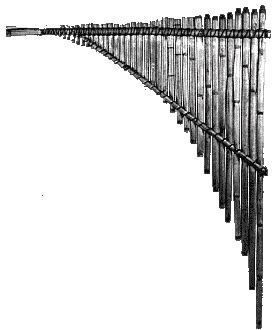 ECUADORIAN
RONDADOR
ECUADORIAN
RONDADOR
Bolivian flute makers from Walata make
this instrument using Rhipidocladum harmonicum, which results in a high
quality, refined pan flute. However, it seems that they use this
species for the simple reason that they have an abundance of this bamboo.
Very large siku, called toyo (also known as taika in the Aymara language)
are made in another bamboo, the species of which still eludes me.
It has a rough surface, and although it has very long internodes, hard
walls and an incredibly cylindrical bore, sometimes the longer tubes are
the result of a two pipes being joined carefully together. This bamboo
is found in the Chapare, near Cochabamba, Bolivia, and could be either
an Aulonemia, or less likely, a Guadua species.
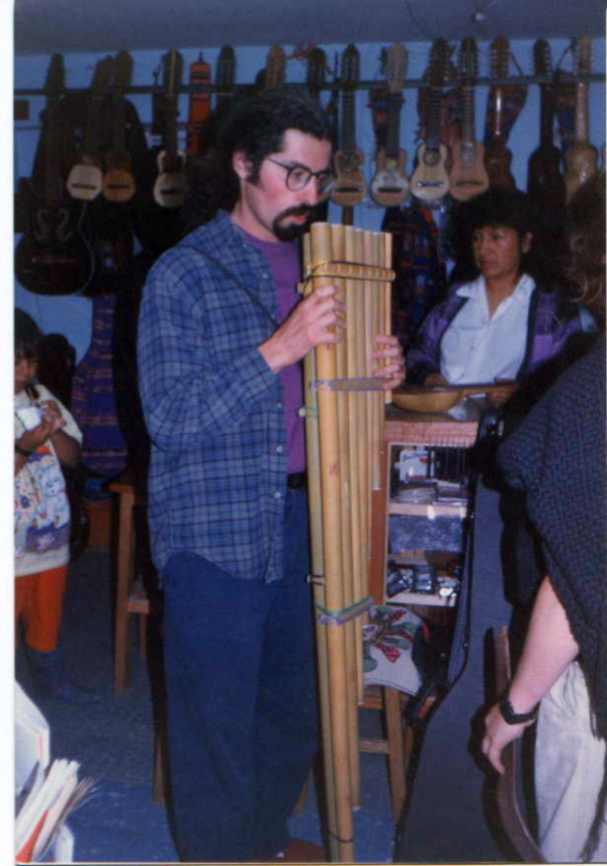
THE AUTHOR PLAYING A 1,6 M
TOYO IN BOLIVIA
(also called taika, grandmother
in Aymara language)
Modern approaches to making
pan flutes:
When Andean music became popular outside
their frontiers, flute makers have made siku and antaras of different materials
and, of course bamboo species. In Argentinean cities, the revival
of traditional Inca instruments began in the 1960s, reaching its zenith
in the 1980s.
Several bamboo species have been introduced
near Buenos Aires, mainly in the Delta del Parana at the North, which has
a temperate micro climate zone, and in Berisso at the South of the metropolis.
Local flute makers have used these introduced species to make flutes, such
as Bambusa tuldoides (“Punting Pole Bamboo”) and Pseudosasa japonica (“Arrow
Bamboo”).
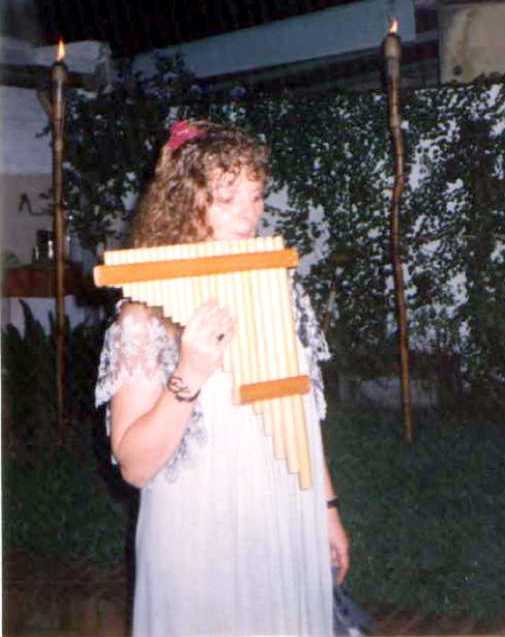
MARIANA PLAYING AN EUROPEAN STYLE ARUNDINARIA
PANFLUTE, made by Angel.
So-called “local” varieties, which were
actually introduced, are high valued, including the traditional flute makers
of the Andean zone of the N.W. of Argentina. I was surprised when
I met a traditional Jujuyan flute maker who told me "Oh, you have the canes
from the Delta!" referring to the Pseudosasa japonica.
Pseudosasa japonica has long internodes
with thin walls, and an excellent internal diameter to length ratio, especially
at the upper part of the culm. They are quite good for European pan
flutes, but the walls are not thin enough to produce the Rhiphidocladum
effect. Paulo Carri, a Buenos Aires flute maker, has overcome this
problem by designing a special embouchure (mouthpiece) by reducing the
walls at the mouth end and giving a certain inclination for each note.
He makes excellent, though expensive siku and chromatic antaras following
the piano distribution.
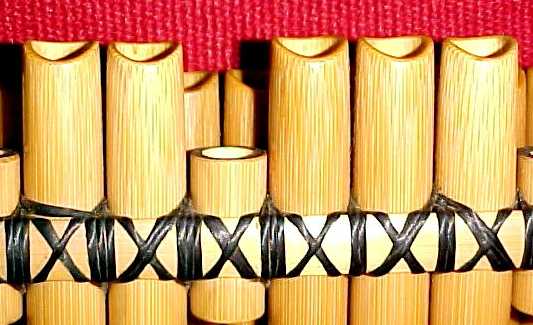
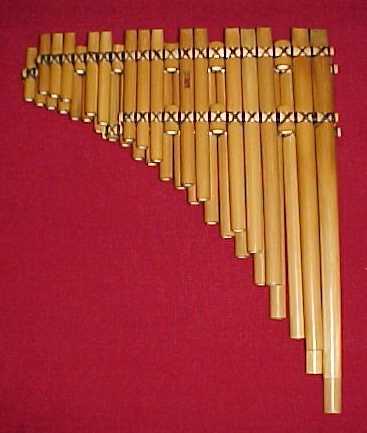
Chromatic Antara MADE BY
PAULO CARRI. The right photo shows the embouchure of the reduced
walls tubes
Pseudosasa pan flutes are made by carefully
selecting pipes that have a plain, well-rounded sound that is easy to play.
Traditional Andean pan flutes have a natural septum at the far end.
Modern flute makers cut the tubes a bit longer for each note, and then
seal them with a movable rubber plug. This is difficult to do with
Rhipidocladum, due to their thin fragile walls, but this works perfectly
well with Pseudosasa japonica. This method is very useful here, because
most of the Bolivian or Peruvian siku are tuned in the Altiplano, under
a particular atmospheric pressure due to the altitude. These flutes
are normally out of tune at lower elevations though. Rhipidocladum
sikus are hand made with small knives in the Altiplano. When I brought
to Buenos Aires Rhipidocladum tubes for first the time, I machined them
in the same way as the other bamboos. So, when I cut the tubes with
a band saw, I was surprised by the sparks, probably due to the high content
of silica in their thin but very hard wall. In fact, Rhipidocladum
culms have a slightly sandy texture.
One can purchase a pan flute or siku at
a wide range of prices, the quality being invisible to the novice.
Professional flute makers make them tube by tube, actually working on each
note and carefully selecting the length to diameter relationship, and sometimes
the result of such a work is almost invisible. Each bamboo tube is
sanded outside and inside, oiled or lacquered and polished with a buffer.
I would like to thank dra.
Zulma
Rúgolo de Agrásar, Instituto de Botánica Darwinion,
Paco
Jiménez and
Paulo Carri
(musicians).
For more info, contact
Angel Sampedro del Río
info@unmundodebambu.com.ar